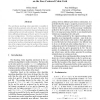Free Online Productivity Tools
i2Speak
i2Symbol
i2OCR
iTex2Img
iWeb2Print
iWeb2Shot
i2Type
iPdf2Split
iPdf2Merge
i2Bopomofo
i2Arabic
i2Style
i2Image
i2PDF
iLatex2Rtf
Sci2ools
ICIAP
2007
ACM
2007
ACM
Topology Preserving Marching Cubes-like Algorithms on the Face-Centered Cubic Grid
The well-known marching cubes algorithm is modified to apply to the face-centered cubic (fcc) grid. Thus, the local configurations that are considered when extracting the local surface patches are not cubic anymore. This paper presents three different partitionings of the fcc grid to be used for the local configurations. The three candidates are evaluated theoretically and experimentally and compared with the original marching cubes algorithm. It is proved that the reconstructed surface is topologically equivalent to the surface of the original object when the surface of the original object that is digitized is smooth and a sufficiently dense fcc grid is used.
| Added | 08 Dec 2009 |
| Updated | 08 Dec 2009 |
| Type | Conference |
| Year | 2007 |
| Where | ICIAP |
| Authors | Robin Strand, Peer Stelldinger |
Comments (0)

